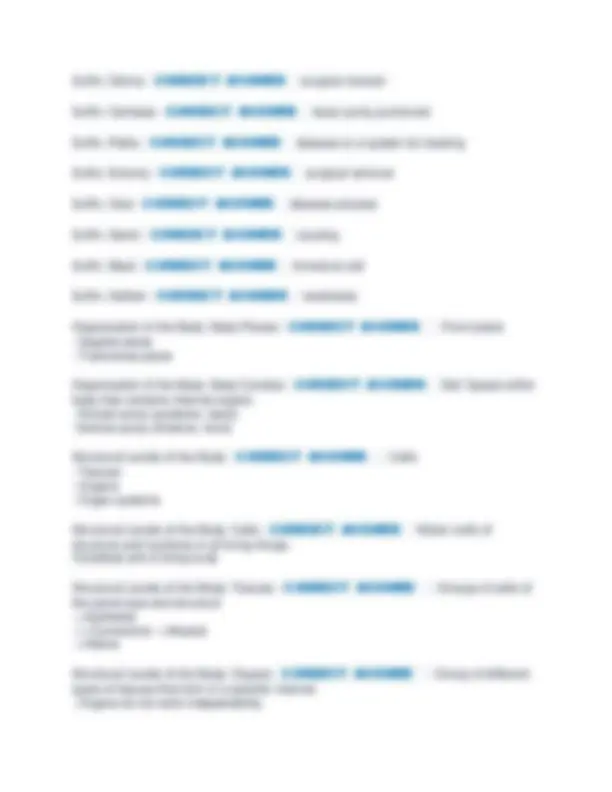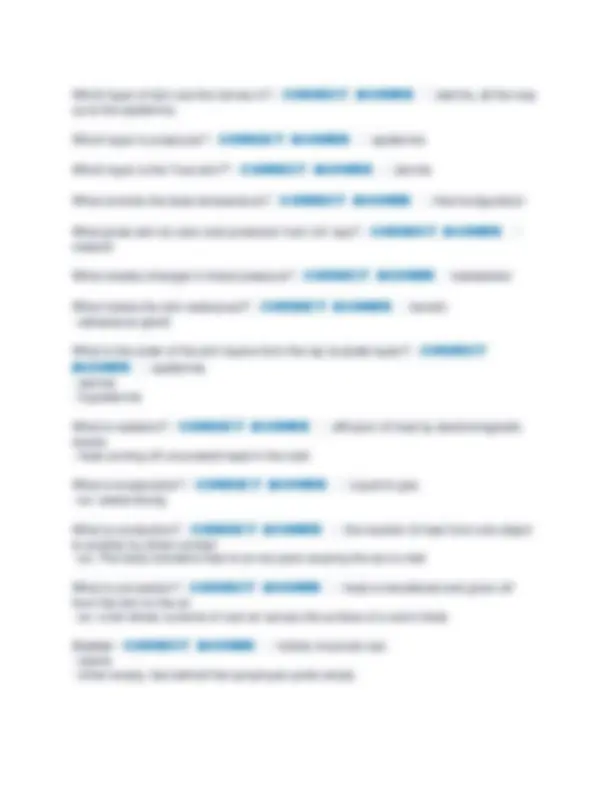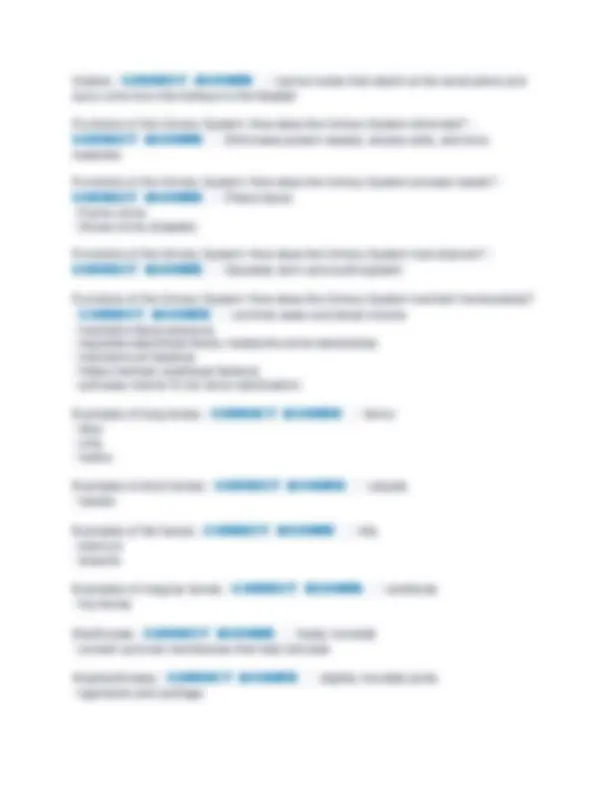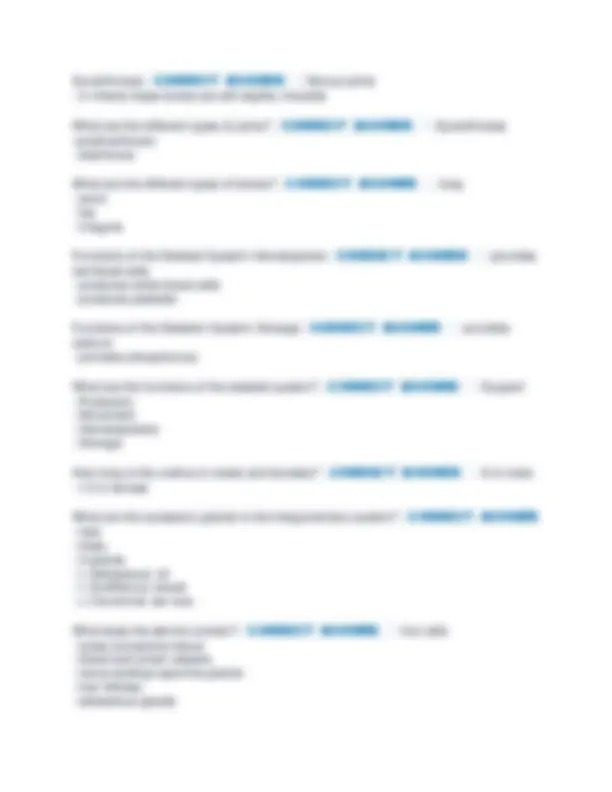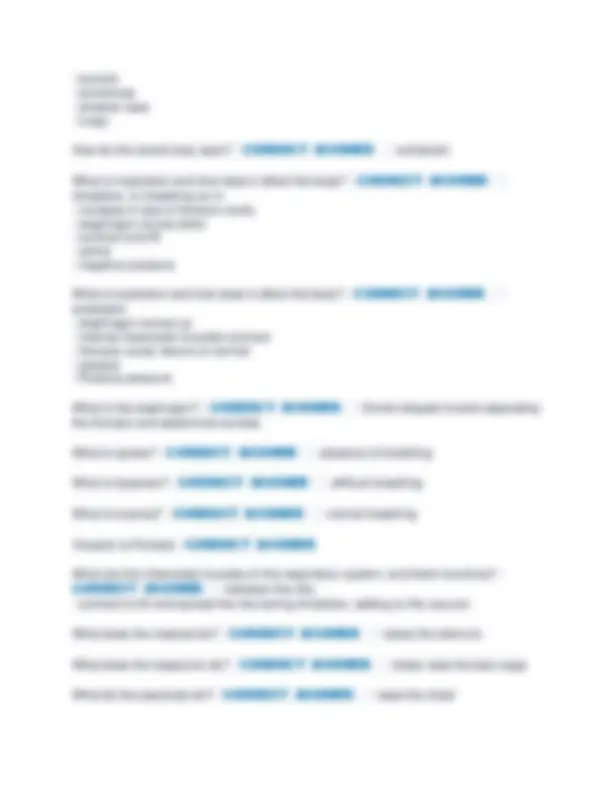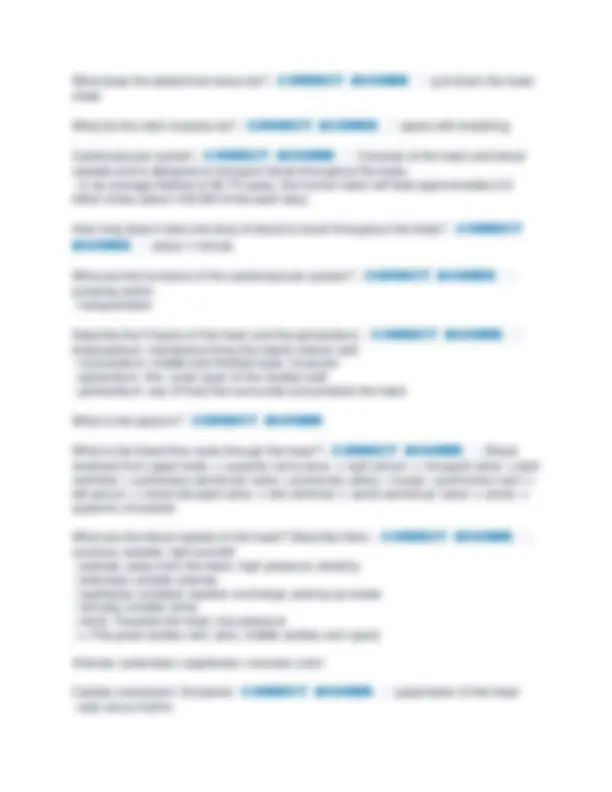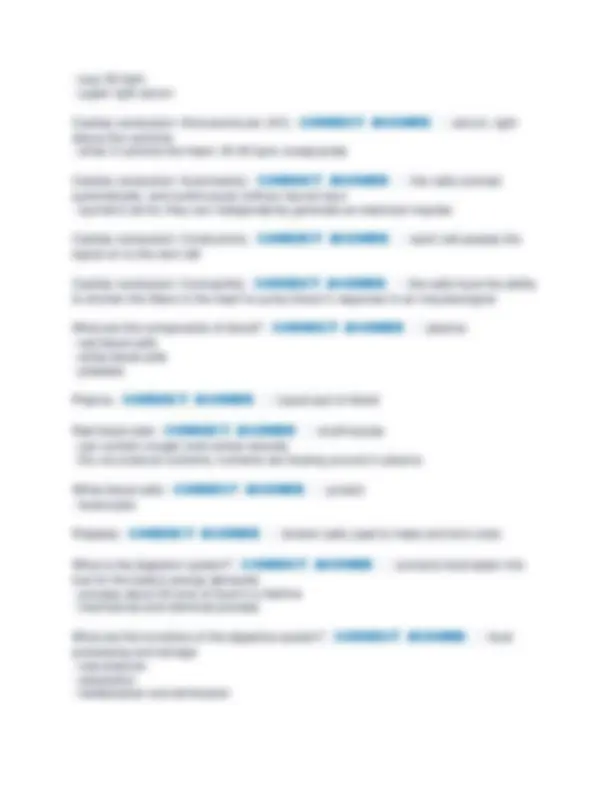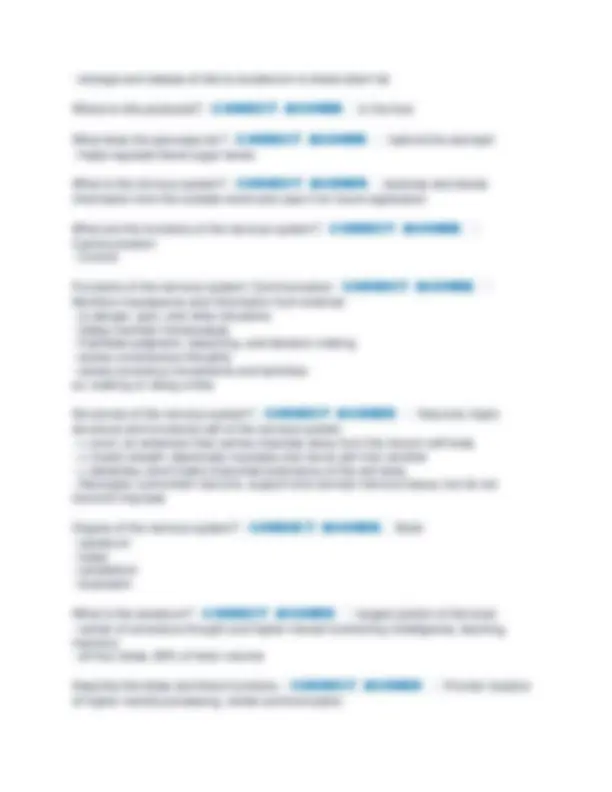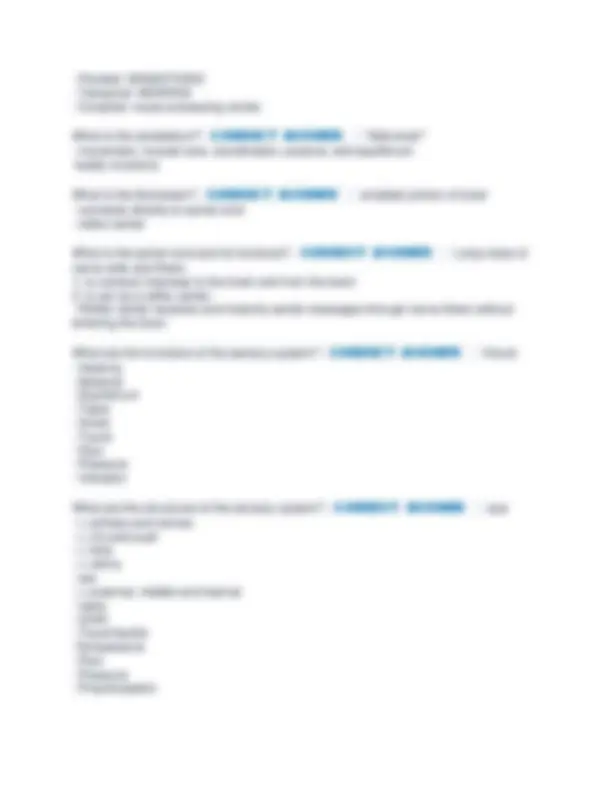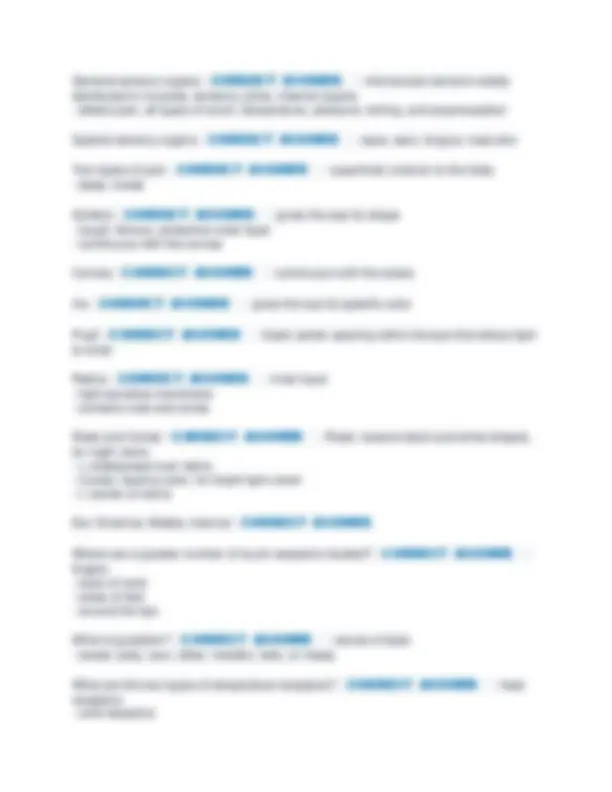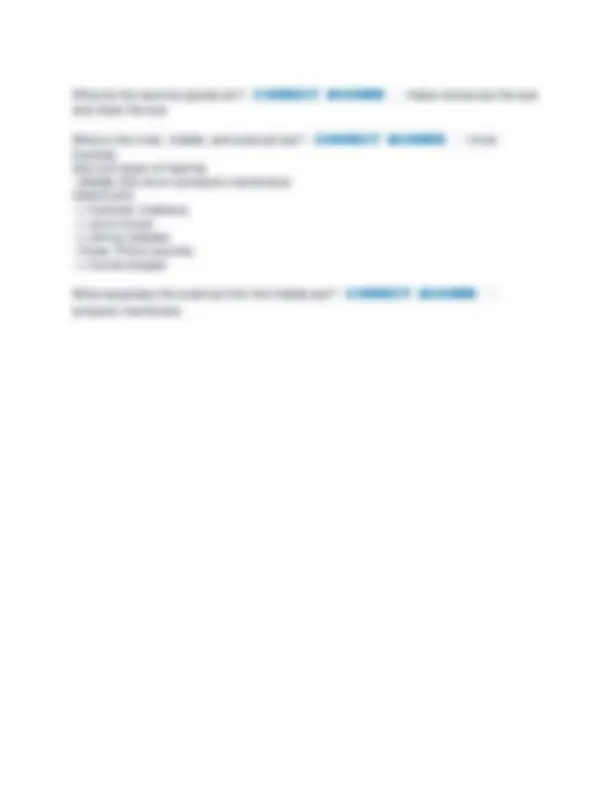Download IBAM Test 1 ACTUAL EXAM] LATEST VERSION [250 QUESTIONS AND ANSWERS] WITH STUDY GUIDE DETA and more Exams Nursing in PDF only on Docsity!
IBAM Test 1 ACTUAL EXAM] LATEST VERSION [ 250 QUESTIONS AND
ANSWERS] WITH STUDY GUIDE DETAILED AND VERIFIED FOR
GUARANTEED PASS- LATEST UPDATE 2025 GRADED A
Bones: Upper extremities - CORRECT ANSWER •Clavicles •Scapula •Humerus •Ulna •Radius •Carpals •Metacarpals •Phalanges What are the parts of the spine, and how many vertebrae do they each contain? - CORRECT ANSWER - cervical: 7
- thoracic: 12
- lumbar: 5
- sacrum: 1
- coccyx: 1
- 26 total What are the three parts of the sternum? - CORRECT ANSWER - manubrium
- body
- zyphoid process How many pairs of ribs in the thoracic rib cage? And what is there function? - CORRECT ANSWER - 12 pairs
- protects all vital organs Bones: Pelvic Girdle - CORRECT ANSWER - ilium
- ischium
- pubis symphysis How many bones are in the skull? - CORRECT ANSWER 28 Types of freely movable joints and examples. - CORRECT ANSWER - Hinge:
- Ball and Socket:
- Pivot:
- Gliding:
- Condyloid:
- Saddle: What does the hypodermis contain and provide? - CORRECT ANSWER - fatty layer
- insulates, cushions, and protects
- contains lipocytes Root: Viscer - CORRECT ANSWER visceral organs Root: Trich - CORRECT ANSWER hair Root: Radius - CORRECT ANSWER forearm bone; thumbside Root: Ren - CORRECT ANSWER kidney Root: Tact - CORRECT ANSWER touch Root: Tom - CORRECT ANSWER cut Root: Sepsis - CORRECT ANSWER microorganism or toxin in blood Root: Serum - CORRECT ANSWER clear portion of body fluids; including blood Root: Som - CORRECT ANSWER body Root: Sinus - CORRECT ANSWER cavity channel or hollow space Root: Stature - CORRECT ANSWER height Root: Toxic - CORRECT ANSWER poisonous Root: Retina - CORRECT ANSWER inner nerve containing layer of eye Root: Sangui - CORRECT ANSWER blood Root: Sept - CORRECT ANSWER wall divider; 7 Root: Viscous - CORRECT ANSWER sticky Root: Stasis - CORRECT ANSWER slowing or stopping of the normal flow of fluids Root: Ur - CORRECT ANSWER urine Phot - CORRECT ANSWER light Root: Pod - CORRECT ANSWER foot
Prefix: Brady - CORRECT ANSWER slow Prefix: Hyper - CORRECT ANSWER over, excessive Prefix: Ortho - CORRECT ANSWER straight or normal Prefix: Hemat - CORRECT ANSWER pertaining to blood Prefix: Cardio - CORRECT ANSWER pertaining to heart Prefix: Contra - CORRECT ANSWER against; opposed to Prefix: An - CORRECT ANSWER lack of Prefix: Cyst - CORRECT ANSWER pertaining to bladder or sac Prefix: Macro - CORRECT ANSWER large Prefix: Intra - CORRECT ANSWER within Prefix: Ex - CORRECT ANSWER outside Prefix: Dermat - CORRECT ANSWER pertaining to skin Prefix: Cephal - CORRECT ANSWER pertaining to the head Prefix: Hypo - CORRECT ANSWER under; deficient Prefix: Bio - CORRECT ANSWER pertaining to life Suffix: Itis - CORRECT ANSWER inflammation Suffix: Oma - CORRECT ANSWER tumor Suffix: Cyte - CORRECT ANSWER Cell Suffix: Algia - CORRECT ANSWER pertaining to pain Suffix: Gram - CORRECT ANSWER record Suffix: Ology - CORRECT ANSWER science of
Suffix: Otomy - CORRECT ANSWER surgical incision Suffix: Centesis - CORRECT ANSWER body cavity punctured Suffix: Pathy - CORRECT ANSWER disease or a system for treating Suffix: Ectomy - CORRECT ANSWER surgical removal Suffix: Osis - CORRECT ANSWER disease process Suffix: Genic - CORRECT ANSWER causing Suffix: Blast - CORRECT ANSWER immature cell Suffix: Asthen - CORRECT ANSWER weakness Organization of the Body: Body Planes - CORRECT ANSWER - Front plane
- Sagittal plane
- Transverse plane Organization of the Body: Body Cavities - CORRECT ANSWER Def: Space within body that contains internal organs
- Dorsal cavity (posterior, back)
- Ventral cavity (Anterior, front) Structural Levels of the Body - CORRECT ANSWER - Cells
- Tissues
- Organs
- Organ systems Structural Levels of the Body: Cells - CORRECT ANSWER •Basic units of structure and functions in all living things. •Smallest unit of living body Structural Levels of the Body: Tissues - CORRECT ANSWER - Groups of cells of the same type and structure -->Epithelial --> Connective -->Muscle -->Nerve Structural Levels of the Body: Organs - CORRECT ANSWER - Group of different types of tissues that form in a specific manner.
- Organs do not work independently
What is conductivity within the nerve tissue? - CORRECT ANSWER - receive and send impulse What is the Urinary System? - CORRECT ANSWER - known as the body's "filtration and removal plant." - Circulating blood carries wastes from the cells to the kidneys for urinary elimination. What are the four functions of the Urinary system? - CORRECT ANSWER 1. Maintenance of Homeostasis
- Manufacture
- Processing of Waste
- Elimination What are the structures of the Urinary System? - CORRECT ANSWER - Kidneys
- Ureters
- Bladder
- Urethra Kidneys - CORRECT ANSWER - Reddish brown bean-shaped organs in the small of the back What do the renal arteries do? What supplies them with blood? - CORRECT ANSWER - carry blood away from the kidney
- abdominal aorta provides the renal arteries with blood What do the renal veins do? - CORRECT ANSWER - carry blood to the kidney How does the urinary system influence homeostasis? - CORRECT ANSWER - eliminating waste from the body
- regulating blood acidity levels
- controlling the levels of metabolites and electrolytes in the blood What is the very first layer of the skin? - CORRECT ANSWER - horny layer (corneum) What are the functions of the integumentary system? - CORRECT ANSWER - protection
- thermoregulation
- metabolism
- sensation
- communication
- storage What is your body core temperature? - CORRECT ANSWER - 98.
Which layer of skin are the nerves in? - CORRECT ANSWER - dermis, all the way up to the epidermis. Which layer is avascular? - CORRECT ANSWER - epidermis Which layer is the "true skin?" - CORRECT ANSWER - dermis What controls the body temperature? - CORRECT ANSWER - thermoregulation What gives skin its color and protection from UV rays? - CORRECT ANSWER - melanin What creates changes in blood pressure? - CORRECT ANSWER metabolism What makes the skin waterproof? - CORRECT ANSWER - keratin
- sebaceous gland What is the order of the skin layers from the top (outside layer)? - CORRECT ANSWER - epidermis
- dermis
- hypodermis What is radiation? - CORRECT ANSWER - diffusion of heat by electromagnetic waves
- heat coming off uncovered head in the cold What is evaporation? - CORRECT ANSWER - Liquid to gas
- ex: sweat drying What is conduction? - CORRECT ANSWER - the transfer of heat from one object to another by direct contact
- ex: The body transfers heat to an ice pack causing the ice to melt What is convection? - CORRECT ANSWER - heat is transferred and given off from the skin to the air
- ex: a fan blows currents of cool air across the surface of a warm body Bladder - CORRECT ANSWER - hollow muscular sac
- sterile
- when empty, lies behind the symphysis pubis empty
Synarthroses - CORRECT ANSWER - fibrous joints
- in infants these bones are still slightly movable What are the different types of joints? - CORRECT ANSWER - Synarthroses
- amphiarthrosis
- diarthrosis What are the different types of bones? - CORRECT ANSWER - long
- short
- flat
- irregular Functions of the Skeletal System: Hematopoisis - CORRECT ANSWER - provides red blood cells
- produces white blood cells
- produces platelets Functions of the Skeleton System: Storage - CORRECT ANSWER - provides calcium
- provides phosphorous What are the functions of the skeletal system? - CORRECT ANSWER - Support
- Protection
- Movement
- Hematopoiesis
- Storage How long is the urethra in males and females? - CORRECT ANSWER - 8 in male
- 1.5 in female What are the accessory glands to the integumentary system? - CORRECT ANSWER
- Hair
- Nails
- 3 glands --> Sebaceous: oil --> Sudiferous: sweat --> Ceruminal: ear wax What does the dermis contain? - CORRECT ANSWER - live cells
- loose connective tissue
- blood and lymph vessels
- nerve endings apocrine glands
- hair follicles
- sebaceous glands
- sudoriferous glands
- elastin
- collagen, fibrin
- Papillary layer and reticular layer Abdominal Quadrants - CORRECT ANSWER - Right Upper: liver, gallbladder, kidney, stomach (small amount), large intestine, small intestine, duodenum, pancreas
- Right Lower: appendix, small intestine, ureter, large intestine, cecum
- Left Upper: liver, stomach, pancreas, kidney, spleen, transverse and large intestine, small intestine
- Left Lower: small intestine, large intestine, ureter What do ligaments connect? - CORRECT ANSWER - bone to bone What kind of tissue is cartilage? - CORRECT ANSWER - connective Why is the pelvic larger and wider for a woman? - CORRECT ANSWER BABIES What are the functions of muscles? - CORRECT ANSWER - voluntary movement
- involuntary movement
- protection What are the different muscle classifications? - CORRECT ANSWER - smooth
- cardiac
- skeletal Describe smooth muscles. - CORRECT ANSWER - wall of hollow organs, vessels, respiratory passageways
- involuntary
- peristalsis Describe cardiac muscles. - CORRECT ANSWER - wall of heart
- involuntary
- own electrical system Describe skeletal muscles. - CORRECT ANSWER - attached to bones
- voluntary What are tendons? - CORRECT ANSWER - muscles to bones
- tendons feel tough, fibrous, and rope-like.
- The Achilles tendon is an example of a tendon attaching calf muscles to the heel. What are the four muscle contractions? - CORRECT ANSWER - contractility
- bronchi
- bronchiole
- alveolar sacs
- lungs How do the alveoli stay open? - CORRECT ANSWER - surfactant What is inspiration and how does it affect the body? - CORRECT ANSWER - inhalation, or breathing air in
- increase in size of thoracic cavity
- diaphragm moves down
- contract and lift
- active
- negative pressure What is expiration and how does it affect the body? - CORRECT ANSWER - exhalation
- diaphragm moves up
- internal intercostal muscles contract
- thoracic cavity returns to normal
- passive
- Positive pressure What is the diaphragm? - CORRECT ANSWER - Dome-shaped muscle separating the thoracic and abdominal cavities. What is apnea? - CORRECT ANSWER - absence of breathing What is dyspnea? - CORRECT ANSWER - difficult breathing What is eupnea? - CORRECT ANSWER - normal breathing Visceral vs Parietal - CORRECT ANSWER What are the intercostal muscles of the respiratory system, and there functions? - CORRECT ANSWER - between the ribs
- contract to lift and spread the ribs during inhalation, adding to the vacuum. What does the mastoid do? - CORRECT ANSWER - raises the sternum What does the trapezium do? - CORRECT ANSWER - helps raise thoracic cage What do the pectorals do? - CORRECT ANSWER - raise the chest
What does the abdominal rectus do? - CORRECT ANSWER - pull down the lower chest What do the neck muscles do? - CORRECT ANSWER - assist with breathing Cardiovascular system - CORRECT ANSWER - Consists of the heart and blood vessels and is designed to transport blood throughout the body.
- In an average lifetime of 65-70 years, the human heart will beat approximately 2. billion times (about 100,000 times each day). How long does it take one drop of blood to travel throughout the body? - CORRECT ANSWER - about 1 minute What are the functions of the cardiovascular system? - CORRECT ANSWER - pumping action
- transportation Describe the 3 layers of the heart and the pericardium. - CORRECT ANSWER - endocardium: membrane lining the hearts interior wall.
- myocardium: middle and thickest layer, muscular
- epicardium: thin, outer layer of the cardiac wall
- pericardium: sac of fluid that surrounds and protects the heart What is the septum? - CORRECT ANSWER What is the blood flow route through the heart? - CORRECT ANSWER - Blood received from upper body--> superior vena cava--> right atrium--> tricuspid valve-->right ventricle--> pulmonary semilunar valve-->pumonary artery-->lungs-->pulmonary vein--> left atrium--> mitral bicuspid valve--> left ventricle--> aortic semilunar valve--> aorta--> systemic circulation What are the blood vessels of the heart? Describe them. - CORRECT ANSWER - coronary vessels: right and left
- arteries: away from the heart, high pressure, stretchy
- arterioles: smaller arteries
- capillaries: smallest vessels, exchange, picking up waste
- venules: smaller veins
- veins: Towards the heart, low pressure --> The great cardiac vein (ant), middle cardiac vein (post) Arteries->arterioles->capillaries->venules->vein Cardiac conduction: Sinoatrial - CORRECT ANSWER - pacemaker of the heart
- sets sinus rhythm
Functions of the Digestive System: Food Processing and Storage - CORRECT ANSWER - breaks down food into smaller particles (mechanical digestion)
- converts food into substances that can be absorbed (chemical digestion)
- moves food materials through the gastrointestinal tract (peristalsis)
- Stores nutrients until needed Functions of the Digestive System: Manufacture - CORRECT ANSWER - manufactures enzymes, hydrochloric acid, intrinsic factor, mucus, and other materials to assist in digestion
- manufactures regulatory hormones in stomach
- manufactures vitamin k and some B- complex vitamins in the large intestine Functions of the Digestive System: Absorption - CORRECT ANSWER - provides absorption of nutrients, mainly from the small intestine into capillaries Functions of the Digestive system: Reabsorption and Elimination - CORRECT ANSWER - reabsorbs water for reuse by the body
- reabsorbs minerals and vitamins
- forms feces from remaining waste products
- produces defecation What are the six parts of the digestive system? - CORRECT ANSWER - Ingestion
- Propulsion
- Breakdown
- Chemical
- Absorption
- Defecation What are the structures of the digestive system? - CORRECT ANSWER - mouth: salivary glands, teeth, tongue, pharynx epiglottis
- esophagus
- small intestine
- large intestine What are the parts of the small intestine and the functions? - CORRECT ANSWER
- duodenum: breaks down fat
- jejunum: breaks down protein
- Ileum: passageway What is Catabolism? Anabolism? - CORRECT ANSWER - Catabolism: Breakdown of larger particles into smaller particles so the body can utilize it for energy
- Anabolism: Synthesis of simple substances into new, organized substances to be used by the body
When does the digestive system begin? - CORRECT ANSWER - when you first smell food, mouth begins to salivate What color is bile? - CORRECT ANSWER - yellowish, green What are the three stages of the digestive system and where do they take place? - CORRECT ANSWER - cephalic: mouth
- gastric: stomach
- intestinal: intestines What is glucose and fatty acid broken down into? - CORRECT ANSWER - fatty acid: cholesterol & steroid
- glucose: glycogen & sugar What does absorption of the food mainly take place in the body? - CORRECT ANSWER - small intestine, specifically the duodenum and jejunum Digestive system: Where are the villi located and what do they do? - CORRECT ANSWER - lines the small intestine
- increases the surface area in order to get as much nutrients as possible
- villi connects to capillaries and sends nutrients to the blood stream What are the three sphincters and where are they located? - CORRECT ANSWER
- cardiac: esophagus and stomach
- pyloric: stomach and duodenum
- Ileocecal: seperates the small and large intestine Order of digestive system - CORRECT ANSWER - Mastication-> saliva - > esophagus (peristalsis)-> cardiac sphincter-> acids turn boluses into chyme in stomach-
pyloric sphincter-> small intestines (absorption)-> ileocecal sphincter-> large intestines (absorption of more water)-> What do the chief and parietal cells do in the stomach? - CORRECT ANSWER - chief cells: pepsinogen-> peptin (break down proteins) ;; gastric lipase ( breaks down triglycerides)
- parietal cells: secretes HCL--> activates pepsinogen--> pepsin--> breaks down proteins & kills most stomach microogranisms What is the regulatory hormone of the stomach? - CORRECT ANSWER - gastrin: stimulates HCL secretion , and pepsinogen
- weakly stimulates pancrease to secrete enzymes and the gallbladder to release bile What does the gallbladder do? - CORRECT ANSWER - located underneath the liver
- Parietal: SENSATIONS
- Temporal: HEARING
- Occipital: visual processing center What is the cerebellum? - CORRECT ANSWER - "little brain"
- movement, muscle tone, coordination, posture, and equilibrium
- bodily functions What is the Brainstem? - CORRECT ANSWER - smallest portion of brain
- connects directly to spinal cord
- reflex center What is the spinal cord and its functions? - CORRECT ANSWER - Long mass of nerve cells and fibers
- to conduct impulses to the brain and from the brain
- to act as a reflex center.
- Reflex center receives and instantly sends messages through nerve fibers without entering the brain. What are the functions of the sensory system? - CORRECT ANSWER - Visual
- Hearing
- Balance
- Equilibrium
- Taste
- Smell
- Touch
- Pain
- Pressure
- Vibration What are the structures of the sensory system? - CORRECT ANSWER - eye --> schlera and cornea --> iris and pupil --> lens --> retina
- ear --> external, middle and internal
- taste
- smell
- Touch/tactile
- Temperature
- Pain
- Pressure
- Proprioception
General sensory organs - CORRECT ANSWER - microscopic sensors widely distributed in muscles, tendons, joints, internal organs
- detect pain, all types of touch, temperature, pressure, itching, and proprioception Special sensory organs - CORRECT ANSWER - eyes, ears, tongue, nose skin Two types of pain - CORRECT ANSWER - superficial: exterior to the body
- deep: inside Schlera - CORRECT ANSWER - gives the eye its shape
- tough, fibrous, protective outer layer
- continuous with the cornea Cornea - CORRECT ANSWER - continuous with the sclera Iris - CORRECT ANSWER - gives the eye its specific color Pupil - CORRECT ANSWER - black center opening within the eye that allows light to enter Retina - CORRECT ANSWER - inner layer
- light-sensitive membrane
- contains rods and cones Rods and Cones - CORRECT ANSWER - Rods: receive black and white shapes, for night vision --> widespread over retina
- Cones: receive color, for bright light vision --> center of retina Ear: External, Middle, Internal - CORRECT ANSWER Where are a greater number of touch receptors located? - CORRECT ANSWER - fingers
- back of neck
- soles of feet
- around the lips What is gustation? - CORRECT ANSWER - sense of taste
- sweet, salty, sour, bitter, metallic, fatty, or meaty What are the two types of temperature receptors? - CORRECT ANSWER - heat receptors
- cold receptors



